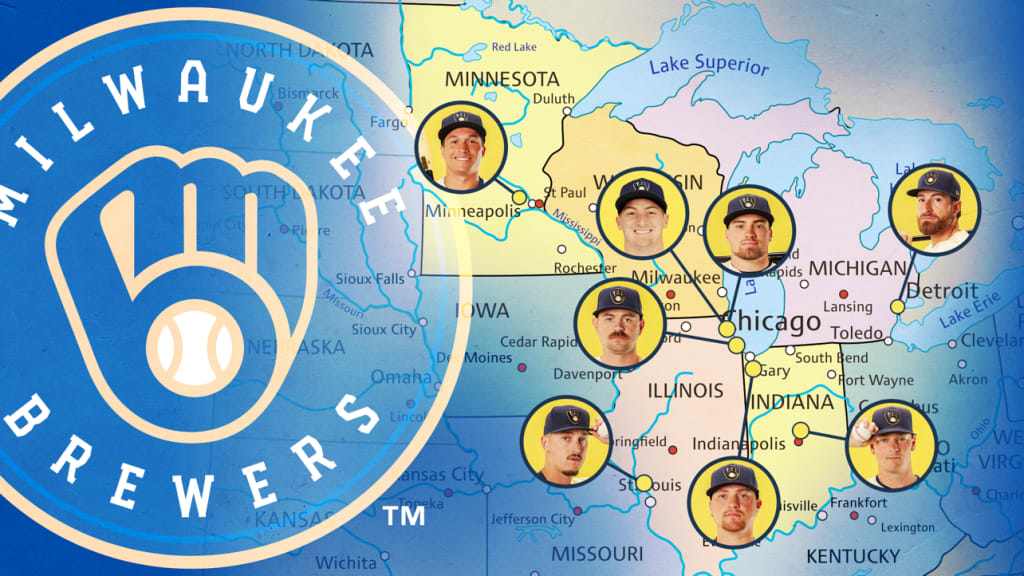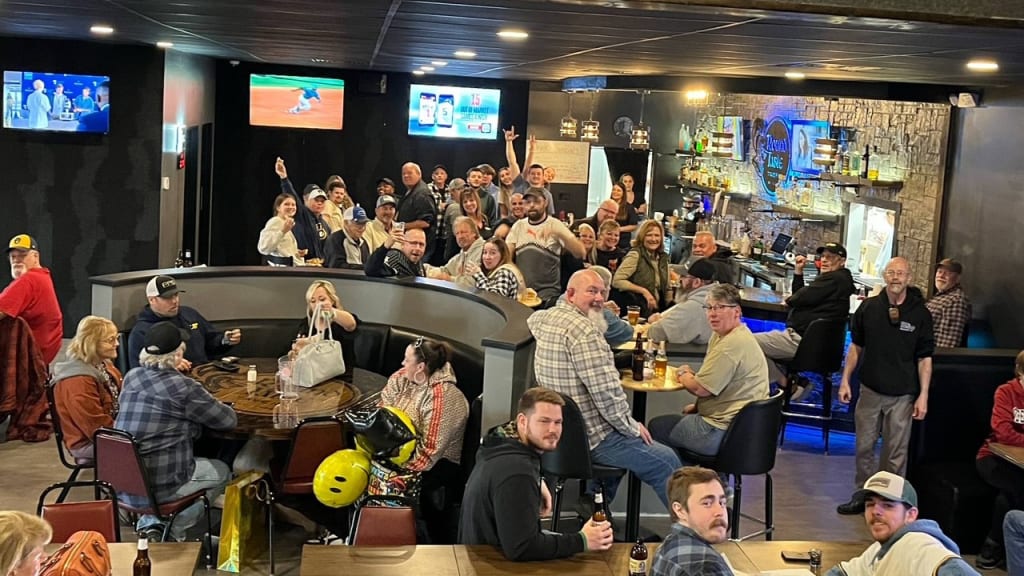
This story was excerpted from Adam McCalvy's Brewers Beat newsletter. To read the full newsletter, click here. And subscribe to get it regularly in your inbox.
MILWAUKEE – The Brewers don’t have a player from Wisconsin, but they have Minnesota, Iowa, Illinois and Michigan covered. Nearly a third of the active roster hailed from those states at the start of this road trip, a surprising contingent of “Midwest nice” for a sport much more represented by warm-weather places like California, Texas, Florida and Latin America than from Appleton, Wis.
That’s where Brewers infield coach Matt Erickson grew up. He’s a fan of the Brewers’ recent Midwestern flavor, and he has an idea why it’s happening.
“You think about the rise of travel baseball, of parents willing to let their kids travel and the rise of indoor baseball facilities – all of that’s almost become normal if you’re going to play higher level baseball,” Erickson said. “I know my path of Little League to Babe Ruth to American Legion ball isn’t the norm anymore. When I went down to Arkansas [for college], it was like me going to Mars.”
Erickson is proud of his roots at Appleton West High School, just like the Brewers’ current crop of Midwesterners are proud of their own hometowns. Here’s what they had to say about home.
Tyler Alexander
Chicago
The lefty is a Texan at heart, since his dad’s job with Valspar (now Sherwin-Williams) took the family to the Dallas-Fort Worth area when he was three months old. But his birth certificate says he’s a Midwesterner, born in Chicago.
“I have a ton of family there – my dad’s from Indiana, mom’s from Chicago,” Alexander said. “They met in Chicago, got married there, had two of their kids there. I’ve always visited a lot. Oak Park, Ill., is where the family is from, but I couldn’t tell you anything about it other than it’s freezing.”
Isaac Collins
Maple Grove, Minn.
Maple Grove is just a very typical suburb of Minneapolis, right where I-94 and I-494 connect,” Collins said. “We really aren’t known for anything, but I will give a shout-out to our high school football team. We’ve won the state title two out of the last three years, so we’re definitely making a good name for ourselves there.”
Collins is part of that football history. He was a captain his senior year as a running back and safety who also returned kickoffs and punts, and in the 2015-16 school year became the first Minnesota high schooler named a finalist for Mr. Baseball and Mr. Football in the state since St. Paul’s Joe Mauer in 2001.
“But he won both. I didn’t win either,” Collins said, laughing.
Caleb Durbin
Lake Forest, Ill.
Commuters know the Lake Forest Oasis along the stretch of Interstate 94 between Milwaukee and Chicago, but there’s a lot more to Durbin’s hometown. Actor Vince Vaughn and Olympic swimmer Matt Grevers graduated from Lake Forest High School, as did Durbin. And it’s the training camp home of the Chicago Bears, though Durbin never made it to practices as a kid because he was busy with baseball or wrestling.
“I think the mentality translates between those sports, and being agile,” Durbin said. “The biggest thing is mindset. It’s just a brutal sport, so when you wrestle competitively for a long time, a lot of other things that you do are going to be easier. Major League Baseball is really, really hard, but I think wrestling has given me an edge as far as knowing how to push myself.”
Eric Haase
Detroit
“Automobiles are the thing,” Haase said. “Growing up, my dad was a mechanic. The best man in my wedding still works for the transmission plant in my hometown. When I think of home, I think of automobiles.”
Haase was born in Detroit proper, where his mother still works as a labor delivery nurse. He grew up just west of the city, attending Divine Child High School in Dearborn, Mich., and eventually settling in Livonia, home of the Livonia Transmission Plant -- at 3.3 million sq. ft., it is the largest transmission plant in the U.S.
“Growing up I loved everything Detroit: Pistons, Lions, Red Wings,” Haase said. “Those were my teams. And I’m still there now.”
Bryan Hudson
Alton, Ill.
The Brewers optioned Hudson to Triple-A Nashville earlier on this trip, but not before he told the tale of how, even at 6-foot-8, he’s the second-most famous big man from Alton, Ill. The world’s tallest man, 8-foot, 11-inch Robert Wadlow, came from Alton, and is recognized by the Guinness Book of World Records as the tallest man "of whom there is irrefutable evidence."
“I grew up right next to his memorial,” Hudson said. “It’s eight feet tall, with his chair. His house is right behind it. People stop there all the time to look at it, take pictures and read the memorial. I’ve stood next to it, and he’s a giant.”
Alton is also home to the Piasa Bird, a creature from Native American mythology depicted in a mural painted on the bluffs above the Mississippi. Hudson owns a couple of homes there and likes being close to friends and family as he tries to secure a Major League foothold in Milwaukee.
“It’s a great place to grow up, a great place to live,” Hudson said.
Chad Patrick
Hebron, Ind.
Nothing against Crown Point, Ind., which appears on Patrick’s birth certificate and thus is listed as his birthplace in MLB’s official database. But Patrick considers himself born and bred in nearby Hebron, where at least five generations of his family has graduated from the local high school.
“My family goes way back there,” Patrick said. “I farm in the offseason for my cousin’s grandma, which is cool. I grew up being really close with my cousins, and they needed somebody to help plow. I hung around the farm growing up and knew what I was doing, so why not? I plow and run the auger cart – corn, beans and stuff.”

After a hard day’s work, Patrick and his friends meet at Region Bowl for a couple of cold ones. He knew the place would be packed earlier this month when he pitched a Saturday game in Arizona, so Patrick stopped by the week before and pre-paid for a round for the whole bar.
“It’s a chill town,” Patrick said. “They’ve always supported me there.”
Quinn Priester
Cary, Ill.
Football was a big part of Priester’s childhood growing up in McHenry County on the Illinois-Wisconsin border. He caught a touchdown pass for Cary-Grove High School when the Trojans won the Illinois 6A state championship in 2018 and had a scholarship offer from Northwestern to try his luck as a two-way player in football and baseball. But even before the Pirates made Priester the 18th overall pick in the 2019 MLB Draft, it was clear that baseball offered the best path to success.
“My town always cared so much about football, and it was a big reason why I liked doing it,” Priester said. “Every Friday when you were little, you finished your own practice, threw your jersey on and watched the high school game.
“It was just a very normal, humble, blue-collar kind of town. Freshman year of high school, I thought it would be really cool to try to do both sports. Then I realized how big those guys get, and I was like, ‘You know what? I like baseball better, anyway.’”
Craig Yoho
Fishers, Ind.
Ask Yoho where he’s from and he typically answers Indianapolis. But the more specific answer is Fishers, Ind., a rapidly-growing suburb with small town roots. It’s best known as the home of Conner Prairie, a living history museum affiliated with the Smithsonian Institution.
“They have, like, live actors, living out that time,” Yoho said. “It’s pretty cool, but now my hometown has blown up with growth. We have an arena football team now.”
Indeed, the Fishers Freight are joining Indoor Football League this season and will play at the Fishers Event Center, less than four miles from where Yoho was an infielder in high school.
“When I was growing up, it was very slow-feeling. It wasn’t like we were in the city by any means,” Yoho said. “Now I go back there and it’s like, ‘Holy cow, this place is so different.’ It used to be corn fields on every corner. Now it’s strip malls. Things change, I guess.”
